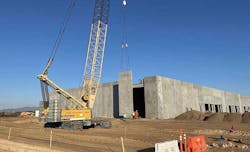Executive Insights: Nancy Novak, Compass and iMasons
The Data Center Frontier Executive Roundtable features insights from industry executives with lengthy experience in the data center industry. Here’s a look at the insights from Nancy Novak of Compass Datacenters and Infrastructure Masons.
NANCY NOVAK, Compass Datacenters and iMasons
With more than 30 years of experience in the construction industry, Nancy Novak brings extensive expertise in oversight and responsibility for Profit and Loss. In her current role as Chief Innovation Officer for Compass Datacenters, her focus is cutting edge technology, lean practices, and innovative culture through diversity of thought to add value, improve return on investment, and disrupt the construction industry. Prior to joining Compass Datacenter’s Novak was National Vice President of Operations for Balfour Beatty Construction. At Balfour Beatty, Novak was a key resource in assessing and strengthening the company’s ability to scale knowledge and bring national consistency to strong, existing operating standards. Previously, her 20 year career as an Operations Executive with Hensel Phelps Construction Company gave her the expertise needed to build complex projects efficiently. Novak is heavily involved in organizations that lead the way for technology advancement in the construction industry, and she is an advocate for women’s leadership. Her passion for advancing women in business occurs through organizations like iMasons, Women for Women International, The National Woman’s Party in Washington DC, Women in Government Relations (WGR), Women Construction Owners and Executives (WCOE), the World Trade Center (WTCI), Fortune Media Most Powerful Women, and Above Glass Ceilings LLC.
Here’s the full text of Nancy Novak’s insights from our Executive Roundtable:
Data Center Frontier: The semiconductor shortage is among the examples of how the supply chain can impact business timetables. How would you assess the state of the data center supply chain, and how it has impacted the industry?
Nancy Novak: While we’ve seen increased costs in some areas for things like steel, the data center industry has probably been less effected by supply chain issues. While the chip shortage may ultimately ripple through to impact the availability of components like PDUs, ATS units and generators, it has not resulted in supply problems for data center building components anywhere near the extent that is has the things like servers that reside within the buildings themselves.
If there is a supply issue from a data center construction perspective, it is found on the labor side of the equation. Contractors and sub-contractors, like many businesses around the country are continually searching for qualified personnel. While there are a number of factors contributing to these shortages, the simple fact is that we are simply not doing enough to find and train the volume of people we need in the skilled trades.
Data Center Frontier: Recent weather-related disasters – including wildfires, winter storms and hurricanes – have tested long-held assumptions about power reliability and air quality in major data center markets. Will this “new normal” require changes in how the data center industry approaches site selection or facility operations?
Nancy Novak: I think we need to be careful about describing recent weather related anomalies as a “new normal”. The cold snap in Texas, for example, was a once-in-a-generation event that was exacerbated by a confluence of underlying issues, but I don’t think anyone is saying “well we won’t be building any new facilities there.”
That being said, I do think you will see the industry broaden the scope of site selection activities beyond the immediate locations being evaluated to look at regional and even state infrastructures to evaluate if there are systemic issues that make them more susceptible to problems during a weather-related event.
A pre-fabricated concrete section being hoisted into place during the construction of a Compass Datacenters campus. (Photo: Compass Datacenters)
Data Center Frontier: If “software is eating the world,” what does that look like for the data center industry? What are the opportunities and challenges presented by a world of “software-defined everything”?
Nancy Novak: The demand for more accessibility to internet delivered applications and functionality isn’t going away and neither is end user demand for instantaneous access. As the network continues to move closer to customers, “decision making” for a variety of elements is going to outstrip the capabilities of human intervention in multiple instances thereby making software-driven automation essential. Developments in AI will be a major growth driver.
Maintaining secure environments will be the biggest challenge, as software defined applications continue to proliferate. This will be more a function of the degree of network expansion as new edge devices, etc. provide new opportunities for hackers. As a result, it will be increasingly important for software defined applications to incorporate the ability to recognize and respond to external intrusion threats. Since “firewall” functionality is often lagging in its response to new intrusion methodologies user decisions as to what information is available and where it’s located will be a major implementation consideration.
Data Center Frontier: As sustainability takes on greater urgency, hyperscale operators are testing new approaches to power infrastructure, including integrating more renewables and innovations in backup power and fuel. What are the most likely advances ahead in data center power?
Nancy Novak: To a certain extent innovations in power delivery will be a function of company size. In multiple areas it’s companies like Google, Microsoft and AWS whose sheer size necessitates they develop solutions to address requirements unique to them that then filter down to smaller providers over time. In terms of power I don’t think it is unreasonable to expect them to become power producers themselves by establishing their own solar or wind powered microgrids to service some if not all of their locations’ power requirements.
While still in the early stages of development, I wouldn’t be surprised to ultimately see one or more of these same companies power their locations through the use of small nuclear reactors. Companies like Bill Gates’ TerraPower are working to develop solutions to make nuclear a more practical energy source, which makes sense since it does not suffer the same limitations as other renewable energy sources.
Naturally, this isn’t something we’re going to see in the next five years but I think we’re increasingly coming to the realization that the ability to meet both corporate and our national emissions reductions goals is going to have to incorporate nuclear technology.
Perhaps the area that will have the largest near term impact on the whole power equation is battery technology. The ability to store energy produced by wind and solar is the major hurdle that needs to be overcome to increase their efficiency to the point that they are true fossil fuel alternatives.

